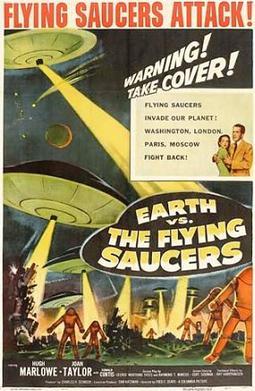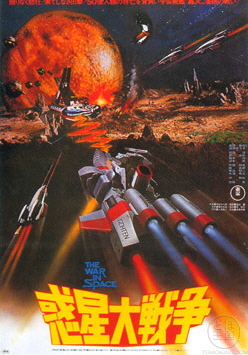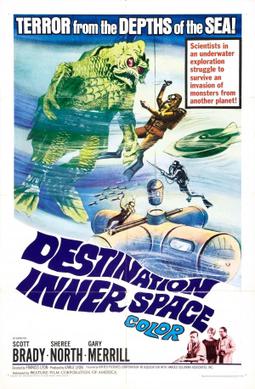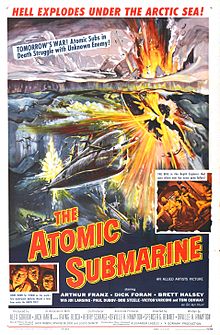
The Thing from Another World, sometimes referred to as just The Thing, is a 1951 American black-and-white science fiction-horror film, directed by Christian Nyby, produced by Edward Lasker for Howard Hawks' Winchester Pictures Corporation, and released by RKO Radio Pictures. The film stars Margaret Sheridan, Kenneth Tobey, Robert Cornthwaite, and Douglas Spencer. James Arness plays The Thing. The Thing from Another World is based on the 1938 novella "Who Goes There?" by John W. Campbell.
UFO conspiracy theories are a subset of conspiracy theories which argue that various governments and politicians globally, in particular the United States government, are suppressing evidence that unidentified flying objects are controlled by a non-human intelligence or built using alien technology. Such conspiracy theories usually argue that Earth governments are in communication or cooperation with extraterrestrial visitors despite public disclaimers, and further that some of these theories claim that the governments are explicitly allowing alien abduction.

UFO is a 1970 British science fiction television series about the covert efforts of an international defence organisation to prevent an alien invasion of Earth. It was created by Gerry Anderson and Sylvia Anderson with Reg Hill, and produced by the Andersons and Lew Grade's Century 21 for Grade's ITC Entertainment company.
The extraterrestrial hypothesis (ETH) proposes that some unidentified flying objects (UFOs) are best explained as being physical spacecraft occupied by extraterrestrial intelligence or non-human aliens, or non-occupied alien probes from other planets visiting Earth.
In ufology, the psychosocial hypothesis, abbreviated PSH, argues that at least some UFO reports are best explained by psychological or social means. It is often contrasted with the better-known extraterrestrial hypothesis (ETH), and is particularly popular among UFO researchers in the United Kingdom, such as David Clarke, Hilary Evans, the editors of Magonia magazine, and many of the contributors to Fortean Times magazine. It has also been popular in France since the publication in 1977 of a book written by Michel Monnerie, Et si les ovnis n'existaient pas?.

It Came from Beneath the Sea is a 1955 American science fiction monster horror film from Columbia Pictures, produced by Sam Katzman and Charles Schneer, directed by Robert Gordon, that stars Kenneth Tobey, Faith Domergue, and Donald Curtis. The screenplay by George Worthing Yates was designed to showcase the stop motion animation special effects of Ray Harryhausen.

Little green men is the stereotypical portrayal of extraterrestrials as little humanoid creatures with green skin and sometimes with antennae on their heads. The term is also sometimes used to describe gremlins, mythical creatures known for causing problems in airplanes and mechanical devices. Today, these creatures are more commonly associated with an alleged alien species called greys, whose skin color is described as not green, but grey.

Earth vs. the Flying Saucers is a 1956 American science fiction film from Columbia Pictures. It was produced by Charles H. Schneer, directed by Fred F. Sears, and stars Hugh Marlowe and Joan Taylor. The stop-motion animation special effects were created by Ray Harryhausen. The storyline was suggested by the bestselling 1953 non-fiction book Flying Saucers from Outer Space by Maj. Donald Keyhoe. The film was released as a double feature with The Werewolf.

Invaders from Mars is a 1953 independently made American SuperCinecolor science fiction film directed by William Cameron Menzies and starring Jimmy Hunt, Helena Carter, Arthur Franz, Morris Ankrum, Leif Erickson, and Hillary Brooke. It was produced by Edward L. Alperson Jr and was distributed by Twentieth Century-Fox.

Many works of fiction have featured UFOs. In most cases, as the fictional story progresses, the Earth is being invaded by hostile alien forces from outer space, usually from Mars, as depicted in early science fiction, or the people are being destroyed by alien forces, as depicted in the film Independence Day. Some fictional UFO encounters may be based on real UFO reports, such as Night Skies. Night Skies is based on the 1997 Phoenix UFO Incident.

Latitude Zero is a 1969 tokusatsu science fiction film directed by Ishirō Honda, with special effects by Eiji Tsuburaya. An international co-production of Japan and the United States, it stars Joseph Cotten, Cesar Romero, Akira Takarada, Masumi Okada, Richard Jaeckel, Patricia Medina, and Akihiko Hirata.

The War in Space, released in Japan as Great Planet War, is a tokusatsu science fiction film produced and released by Toho Studios in 1977.

DeepStar Six is a 1989 American science-fiction horror film about the struggles of the crew of an underwater military outpost to defend their base against the attacks of a sea monster. It was released in January 1989. The film's main actors and supporting players included Greg Evigan, Taurean Blacque, Nancy Everhard, Cindy Pickett, Miguel Ferrer, Nia Peeples, and Matt McCoy.

A flying saucer is a descriptive term for a type of flying craft having a disc or saucer-shaped body, commonly used generically to refer to an anomalous flying object. The term was coined in 1947 but has generally been supplanted since 1952 by the United States Air Force term unidentified flying objects. Early reported sightings of unknown "flying saucers" usually described them as silver or metallic, sometimes reported as covered with navigation lights or surrounded with a glowing light, hovering or moving rapidly, either alone or in tight formations with other similar craft, and exhibiting high maneuverability.

The War of the Worlds is a 1953 American science fiction film directed by Byron Haskin, produced by George Pal, and starring Gene Barry and Ann Robinson. It is the first of several feature film adaptations of H. G. Wells' 1898 novel of the same name. The setting is changed from Victorian era England to 1953 Southern California.

The Rift, also known as Endless Descent, is a 1990 film directed by Juan Piquer Simón and starring R. Lee Ermey. The story involves a submarine rescue that goes awry. It is one of many underwater-themed movies released around 1990, including The Abyss, Leviathan, DeepStar Six, The Evil Below, Hunt for Red October, and Lords of the Deep.

Creature with the Atom Brain is a 1955 American zombie horror science fiction film directed by Edward L. Cahn and starring Richard Denning.

Destination Inner Space is a 1966 science fiction film produced by Earl Lyon, directed by Francis D. Lyon, written by Arthur C. Pierce, and stars Scott Brady, Gary Merrill, and Sheree North. The film was released to theaters in the US in May 1966 on a double bill with Frozen Alive (1964); its broadcasting rights were pre-sold to television so that some of the licensing fee could be used to finance the film's production. The story centers on scientists working in a laboratory on the floor of the ocean. They encounter an undersea flying saucer, after which the lab is attacked by a colorful aquatic humanoid monster who they fear may be the first in an alien invasion.
Jason Colavito is an American author and independent scholar specializing in the study of fringe theories particularly around ancient history and extraterrestrials. Colavito has written a number of books, including The Cult of Alien Gods (2005), The Mound Builder Myth (2020), and Legends of the Pyramids (2021).

Fearful Attack of the Flying Saucers is a 1956 independent Japanese tokusatsu science fiction film directed and written by Shinichi Sekizawa, with special effects and cinematography by Sadao Uemura. Produced by Kokumotsu Films and distributed by Shintoho, it is Sekizawa's sole directorial credit and stars Tadao Takashima, Junko Ebata, Taiji Tonoyama, Hiroshi Sugi, Shigeru Amachi, and Junji Masuda. In the film, a group of Japanese scientists deal with a sudden alien invasion by inventing a rocket in order to save the planet.
















